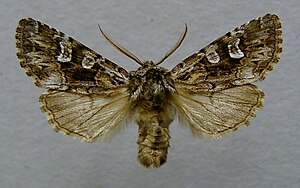Dry grass leaf owl
| Dry grass leaf owl | ||||||||||||
|---|---|---|---|---|---|---|---|---|---|---|---|---|

Dry grass leaf owl ( Pachetra sagittigera ) |
||||||||||||
| Systematics | ||||||||||||
|
||||||||||||
| Scientific name | ||||||||||||
| Pachetra sagittigera | ||||||||||||
| ( Hufnagel , 1766) |
The dry grass leaf owl ( Pachetra sagittigera ) or white-gray garden owl is a butterfly ( moth ) from the family of owl butterflies (Noctuidae).
features
butterfly
The wingspan of the moths is 32 to 45 millimeters, with the females often being particularly large. The color of the fore wings varies considerably, from pale gray to dark gray and reddish brown to dark brown. Primarily climatic or geological influences are responsible for the color design. Kidney and ring flaws are large, often distinctly light gray and sometimes filled with brownish color. The lying W-sign of the wavy line, on the other hand, is mostly indistinct, while the black arrow spots pointing inwards are more conspicuous. The center field and cone blemishes are usually darkened while the interior angle is lightened. The hind wings of the males are a single color, light gray-brown, while the females are somewhat darker. The veins stand out more clearly, as does a central spot. The hem is often drawn alternately brown and light gray on all wings. Because of the antennae , which are combed on both sides , the male moths can be easily distinguished from species with similar drawings. In addition, the wings of both sexes are comparatively short and wide, which gives the butterflies a compact, powerful appearance.
Egg, caterpillar, pupa
The spherical egg, strongly flattened at the bottom, shows distinct ribs on the surface. It is initially yellowish in color, later carmine-red with a wide, white band. The caterpillars are usually light brown in color, have a yellowish back line and wide, dark brown side stripes. The black stigmas stand out clearly . The red-brown doll has a squat shape with a wrinkled cremaster and two points at the end.
Similar species
- Peat owl ( Papestra biren )
- Gray mountain owl ( Lasionycta proxima )
- Arrow-spotted herb owl ( Lacanobia contigua )
- Toothed owl ( hada plebeja )
Geographical distribution and habitat
The species is widespread in Central and Southern Europe and further east continuously to the Urals . To the north, the border runs on the southern edge of England , Sweden and Finland . The southern distribution extends over the Middle East and Central Asia and the Altai to Mongolia . In North Africa the kind is by the ssp. melanophaea (Zerny, 1934). In the Alps, it rises to around 1,300 meters. The dry grass leaf owl prefers dry, open terrain. However, it can also be found in moderately moist forests, bushy grassy areas, scree meadows, gardens and parklands.
Way of life
The dry grass leaf owl forms one generation per year, the moths of which fly from May to July. The moths are predominantly nocturnal, occasionally suckling on the flowers of barberry ( Berberis vulgaris ) and appearing on artificial light sources and baits . The caterpillars live from August. At night they feed on various types of grass, for example real sheep fescue ( Festuca ovina ) as well as panicles ( Poa ) and sweet grasses ( Gramineae ). During the day they hide under dry leaves and stones, sometimes in the loose earth of molehills . The caterpillars overwinter and pupate in April of the following year in a loose web in the ground.
Danger
The dry grass leaf owl is widespread in Germany and can be found in large numbers in certain areas, so that it is not considered endangered.
swell
literature
- Günter Ebert (Ed.): The butterflies of Baden-Württemberg . Volume 7, Nachtfalter V. Ulmer Verlag Stuttgart 1998, ISBN 3-8001-3500-0
- Hermann Hacker, László Ronkay & Márton Hreblay: Noctuidae Europaeae Volume 4, Hadeninae I, Entomological Press, Søro 2002, ISBN 87-89430-07-7
Individual evidence
- ↑ a b Hacker et al. (2002: p. 58/9).
- ^ A b Walter Forster , Theodor A. Wohlfahrt : The butterflies of Central Europe. Volume 4: Owls. (Noctuidae). Franckh'sche Verlagshandlung, Stuttgart 1971, ISBN 3-440-03752-5 .
- ^ Günter Ebert (Ed.): The butterflies of Baden-Württemberg . Volume 7, Nachtfalter V. Ulmer Verlag Stuttgart 1998, ISBN 3-8001-3500-0 (pp. 333-336).
- ↑ Arno Bergmann: The large butterflies of Central Germany. Volume 4/1: Owls. Distribution, forms and communities. Urania-Verlag, Jena 1954, DNB 450378373 .
Web links
- www.lepiforum.de Photos
- www.schmetterlinge-deutschlands.de Endangerment
- www.nic.funet.fi dissemination
- Pachetra sagittigera at Fauna Europaea